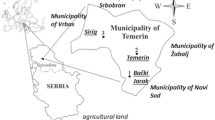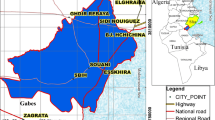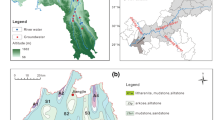Abstract
Drinking water contains geogenic elements to which human beings are exposed; in the long term, these elements can be either harmful (As) or beneficial (Mg and Ca) to health. The composition and relative abundance of the constituents in groundwaters are conditioned by the balance between dissolution, precipitation, and oxide-reduction processes also by the nature and spatial arrangement of the materials interacting with the water. In recent decades, human activities and changes in the use of land have led to the accumulation of organic materials and their degradation into nitrogen and phosphorus, which has resulted in a change of the physicochemical composition and quality of drinking water. The main target of the study was to evaluate the effect of contamination by nitrogen and phosphate organic matter on the physicochemical composition of water used for human consumption. The study was conducted in the Toluca Valley aquifer. The determination of parameters in situ and analysis in the laboratory of physicochemical parameters revealed the presence of NO3− (1.0–119 mg L−1), SO42− (6.81–24.70 mg L−1), PO43− (2.50–32.20 mg L−1), and N-NH4+ (0–5.40 mg L−1), which suggested the presence of punctual anthropogenic contamination; this was confirmed using 3D fluorescence to identify the presence of organic matter. The results of Na+ (15.75 mg L−1), K+ (2.66 mg L−1), Ca2+ (8.73 mg L−1), and Mg2+ (8.01 mg L−1) using the ICP technique showed that the water supplied in the area has a low mineral content. Correlation between P and cations Ca2+ (0.844) > Na+ (0.720) > Mg2+ (0.694) > K+ (0.60) indicates that anthropic contamination affects the relative abundance of dissolved constituents in water. The scarcity of essential nutrients in water impacts on public health; it has been reported that deficiency of Ca2+ and Mg2 implies a wide variety of clinical conditions, mainly in the development of cardiovascular diseases.









Similar content being viewed by others
References
APHA-AWWA-WPCF. (2005). Standard methods for the examination of water and wastewater. Whasington D.C: Joint Editorial Board.
Arheimer, B., & Pers, C. B. (2017). Lessons learned? Effects of nutrient reductions from constructing wetlands in 1996–2006 across Sweden. Ecological Engineering, 103, 404–414.
Brunett, E., Baró, J. E., Cadena, E., & Esteller, M. V. (2010). Pago por servicios ambientales hidrológicos: caso de estudio Parque Nacional del Nevado de Toluca, México. Ciencia Ergo Sum, Universidad Autónoma del Estado de México., 17(3), 286–294.
Burkart, M. R., & Stoner, J. D. (2001). Chapter 6. Nitrogen in groundwater associated with agricultural systems. In Nitrogen in the environment: sources, problems, and management (pp. 123–145).
Deng, A., Ye, C., & Liu, W. (2018). Spatial and seasonal patterns of nutrients and heavy metals in twenty-seven rivers draining into the South China Sea. Water., 10, 50–65.
Expósito, J. L., Esteller, M. V., Paredes, J., Rico, C., & Franco, R. (2010). Groundwater protection using vulnerability maps and wellhead protection area (WHPA): a case study in Mexico. Water Resources Management, 24, 4219–4236.
Fonseca-Montes de Oca, R. M. G., Martínez-Miranda, V., Solache-Ríos Marcos, J., Ramos-Leal, J. A., Álvarez-Bastida, C., & Fuentes-Rivas, R. M. (2019). Chemical activity relation of phosphorus and nitrogen presence in trace elements incorporation into underground water. Environmental Monitoring and Assessment, 191, 93.
Fuentes-Rivas, R. M., Ramos-Leal, J. A., Jiménez-Moleón, M. C., & Esparza-Soto, M. (2015). Caracterización de la Materia Orgánica Disuelta en Agua Subterránea del Valle de Toluca Mediante Espestrofotometría de Fluorescencia 3D. Revista Internacional de Contaminación Ambiental, 31(3), 253–264.
Herath, I., Vithanage, M., Bundschuh, J., Maity, J. P., & Bhattacharya, P. (2016). Natural arsenic in global groundwaters: distribution and geochemical triggers for mobilization. Current Pollution Reports, 2, 68–89.
Hoque, M. A. and Butler, A. P. (2015). Medical Hydrology of Asian Deltas: Status of groundwater toxicans and nutrients and implications for human health. Int. J. Environ. Res. 13:81
Jalali, M. (2009). Phosphorous concentration, solubility and species in the groundwater in a semi-arid basin, southern Malayer, western Iran. Environmental Geology, 57, 1011–1020.
Kaushal, S. S., Duan, S., Doody, T. R., Haq, S., Smith, R. M., Newcomer Johnson, T. A., Delaney Newcomb, K., Gorman, J., Bowman, N., Mayer, P. M., Wood, K. L., Belt, K. T., & Stack, W. P. (2017). Human-accelerated weathering increases salinization, major ions, and alkalinization in fresh water across land use. Applied Geochemistry, 83, 121–135.
Kleber, M., Sollins, A., & Sutton, R. (2007). Conceptual model of organo-mineral interactions in soils: self-assembly of organic molecular fragments into zonal structures on mineral surfaces. Biogeochemistry., 85, 9–24.
Koretsky, C. M., Haas, J. R., Miller, D., & Ndenga, N. T. (2006). Seasonal variations in pore water and sediment geochemistry of littoral lake sediments (Asylum Lake, MI, USA). Geochemical Transactions, 7, 11–37.
Kumar, S. K., Logeshkumaran, A., Magesh, N. S., Godson, P. S., & Chandrasekar, N. (2015). Hydro-geochemistry and application of water quality index (WQI) for groundwater quality assessment, Anna Nagar, part of Chennai City, Tamil Nadu, India. Applied Water Science, 5, 335–343.
Lapworth, D. J., Nkhuwa, D. C. W., Okotto-Okotto, J., Pedley, S., Stuart, M. E., Tijani, M. N., & Wright, J. (2017). Urban groundwater quality in sub-Saharan Africa: current status and implications for water security and public health. Hydrogeology Journal, 25, 1093–1116.
Li, P., Wu, J., Qian, H., Zhang, Y., Yang, N., Jing, L., & Yu, P. (2016). Hydrogeochemical characterization of groundwater in and around a wastewater irrigated forest in the southeastern edge of the Tengger Desert, Northwest China. Exposure and Health, 8, 331–348.
Li, W., Arocena, J. M., Zhang, Q., Thring, R. W., & Li, J. (2017). Heavy metals and nutrients (carbon, nitrogen, and phosphorus) in sediments: relationships to land uses, environmental risks, and management. Environmental Science and Pollution Research, 24, 7403–7412.
Madzin, Z., Shai-in, M. F., & Kusin, F. M. (2015). Comparing heavy metal mobility in active and abandoned mining sites at Bestari Jaya, Selangor. Procedia Environmental Sciences, 30, 232–237.
Martín del Campo, M. A., Esteller, M. V., Expósito, J. L., & Hirata, R. (2014). Impacts of urbanization on groundwater hydrodynamics and hydrochemistry of the Toluca Valley aquifer (Mexico). Environmental Monitoring and Assessment, 186, 2979–2999.
Mockler, E. M., Deakin, J., Archbold, M., Gill, L., Daly, D., & Bruen, M. (2017). Sources of nitrogen and phosphorus emissions to Irish rivers and coastal waters: estimates from a nutrient load apportionment framework. Science of the Total Environment, 601–602, 326–339.
Mwesigye, R. A., & Tumwebaze, B. S. (2017). Water contamination with heavy metals and trace elements from Kilembe copper mine and tailing sites in Western Uganda; implications for domestic water quality. Chemosphere, 169, 281–287.
Nyanduko-Nyairo, W., Okinda Owuor, P., & Orori Kengara, F. (2016). Effect of anthropogenic activities on the water quality of Amala and Nyangores tributaries of River Mara in Kenya. Environmental Monitoring and Assessment, 187, 691.
Rasool, A., Xiao, T., Farooqi, A., Shafeeque, M., Masood, S., Ali, S., Fahad, S., & Nasim, W. (2016). Arsenic and heavy metal contaminations in the tube well water of Punjab, Pakistan and risk assessment: a case study. Ecological Engineering, 95, 90–100.
Robles, E. S., Ramírez, E., Durán, A., Martínez, M. E., & González, M. E. (2013). Calidad Bacteriológica Y Fisicoquímica Del Agua Del Acuífero Tepalcingo-Axochiapan, Morelos, México. Avances en Ciencias e Ingeniería., 4(1), 19–28.
Ruiz, S., Arruti, A., Fernandez-Olmo, I., & Irabien, J. A. (2011). Contribution of point sources to trace metal levels in urban areas surrounded by industrial activities in the Cantabria region (northern Spain). Procedia Environmental Sciences, 4, 76–86.
Sengupta, S., Nawaz, T., & Beaudry, J. (2015). Nitrogen and phosphorus recovery from wastewater. Current Pollution Reports, 1, 155–166.
Sharma, V. K., Jiang J., Kim H. (2013). Ferrate (VI): novel compound for removal of natural organic matter in water. In: Jianming X., Jianjun W., Yan H. Eds. Vol 1. Springer.
Shore, M., Jordan, P., Melland, A. R., Mellander, P.-E., McDonald, N., & Shortle, G. (2016). Incidental nutrient transfers: assessing critical times in agricultural catchments using high-resolution data. Science of the Total Environment, 553, 404–415.
Smolders, A. J. P., Lucassen, E. C. H. E. T., Bobbink, R., Roelofs, J. G. M., & Lamers, L. P. M. (2010). How nitrate leaching from agricultural lands provokes phosphate eutrophication in groundwater fed wetlands: the sulphur bridge. Biogeochemistry., 98, 1–7.
Snoeyink, V.L., Jenkins D. (1980). Water chemistry. Wiley Editor. 480 pag.
Strokal, M., Kroeze, C., Li, L., Luan, S., Wang, H., Yang, S., & Zhang, Y. (2015). Increasing dissolved nitrogen and phosphorus export by the Pearl River (Zhujiang): a modeling approach at the sub-basin scale to assess effective nutrient management. Biogeochemistry., 125, 221–242.
Stubbins, A., & Dittmar T. (2014). Dissolved organic matter in aquatic systems.
Stumm, W., & Morgan, J. I. (1995). Aquatic chemistry: an introduction emphasizing chemical equilibria in natural waters (3ª ed.). Wiley.
Thach, T. T., Harada, M., Oniki, A., Hiramatsu, K., & Tabata, T. (2017). Experimental study on the influence of dissolved organic matter in water and redox state of bottom sediment on water quality dynamics under anaerobic conditions in an organically polluted water body. Paddy and Water Environment, 15, 889–906.
Van Beek, C. L., Droogers, P., Van Hardeveld, H. A., van den Eertwegh, G. A. P. H., Velthof, G. L., & Oenema, O. (2007). Leaching of solutes from an intensively managed peat soil to surface water. Water, Air, and Soil Pollution, 182, 291–301.
Varol, S., & Davraz, A. (2016). Evaluation of potential human health risk and investigation of drinking water quality in Isparta city center (Turkey). Journal of Water and Health, 14(3).
Vrzel, J., Vuković-Gačić, B., Kolarević, S., Gačić, Z., Kračun-Kolarević, M., & Kostić, J. (2016). Determination of the sources of nitrate and the microbiological sources of pollution in the Sava River Basin. Science of the Total Environment, 573, 1460–1471.
Vadde, K., Wang, J., Cao, L., Yuan, T., McCarthy, A., Sekar, R. (2018) Assessment of Water Quality and Identification of Pollution Risk Locations in Tiaoxi River (Taihu Watershed), China. Water 10(2):183
Wodschow, K., Hansen, B., Schullehner, J., & Kjær Ersbøll, A. (2018). Stability of major geogenic cations in drinking water - an issue of public health importance: a Danish study, 1980–2017. International Journal of Environmental Research and Public Health, 15, 1212–1228.
World Health Organization (WHO). (2006). Guides for potable water quality. In Recommendations (Vol. 1, Third ed.).
Wright, K. V., Hartmann, T., & Fujita, Y. (2011). Inducing mineral precipitation in groundwater by addition of phosphate. Geochemical Transactions, 12, 8.
Wu, P., Yin A., Fan M. Wu J., Yang X., Zhang H., Gao H. (2018). Phosphorus dynamics influenced by anthropogenic calcium in an urban stream flowing along an increasing urban.
Zhao, Y., Yang, Z., & Li, Y. (2010). Investigation of water pollution in Baiyangdian Lake, China. Procedia Environmental Sciences, 2, 737–748.
Acknowledgments
The authors thank acknowledge the support given for the development of this project the Autonomous University of the State of Mexico, the Water and Sanitation Agency of Toluca and the Mexican Council of Science and Technology (COMECYT).
Author information
Authors and Affiliations
Corresponding author
Additional information
Publisher’s Note
Springer Nature remains neutral with regard to jurisdictional claims in published maps and institutional affiliations.
Rights and permissions
About this article
Cite this article
de Oca, R.M.G.FM., Ramos-Leal, J.A., Solache-Ríos, M.J. et al. Modification of the Relative Abundance of Constituents Dissolved in Drinking Water Caused by Organic Pollution: a Case of the Toluca Valley, Mexico. Water Air Soil Pollut 230, 171 (2019). https://doi.org/10.1007/s11270-019-4210-1
Received:
Accepted:
Published:
DOI: https://doi.org/10.1007/s11270-019-4210-1




